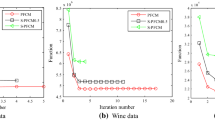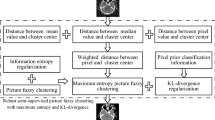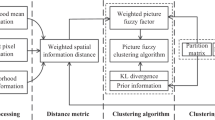Abstract
In the fuzzy clustering process, the clustering number for image or text data to be classified is not easy to determine or unknown. The competitive learning algorithm can automatically determine the optimal clustering number to avoid the problem of inappropriate artificial selection. In this paper, based on the clustering by competitive agglomeration (CA), the idea of the “Competitive Learning Mechanism” is introduced to picture fuzzy clustering to obtain the competitive agglomeration picture fuzzy clustering (CAPFCM). The competitive learning regular term of the CAPFCM objective function is reinterpreted from the perspective of minimizing the entropy, and the general framework of the entropy competitive clustering algorithm is constructed. Moreover, the competitive learning regular term of the objective function is replaced by quadratic entropy, Renyi entropy or Shannon entropy to obtain different entropy competitive clustering. To improve the efficiency of the CAPFCM algorithm, the suppressed factor is introduced to appropriately increase the maximum value of the picture fuzzy partition information for different clusters and suppress all others. In addition, this paper proposes a robust adaptive entropy competitive picture fuzzy clustering segmentation algorithm with neighborhood spatial information constraints to enhance the anti-noise ability of the picture fuzzy clustering algorithm for noise image. Experiments show that robust CAPFCM can automatically determine the clustering number and greatly improve the operation efficiency and segmentation performance.






























Similar content being viewed by others
Explore related subjects
Discover the latest articles and news from researchers in related subjects, suggested using machine learning.References
Bezdek, J.C.: Pattern recognition with fuzzy objective function algorithms. Adv. Appl. Pattern Recogn. 22(1171), 203–239 (1981)
Yu, P., Wang, S.T.: Semi-supervised spatial competitive aggregation algorithm and its application in image segmentation. Comput. Eng. 41(2), 234–241 (2015). (in Chinese)
Bezdek, J.C., Ehrlich, R., Full, W.: FCM: the fuzzy c-means clustering algorithm. Comput. Geoences 10(2), 191–203 (1984)
Velmurugan, T.: Performance based analysis between K-Means and Fuzzy C-Means clustering algorithms for connection oriented telecommunication data. Appl. Soft Comput. 19, 134–146 (2014)
Atanassov, K.T.: Intuitionistic fuzzy sets. Fuzzy Sets Syst. 20(1), 87–96 (1986)
Hung, W.L., Lee, J.S., Fuh, C.D.: Fuzzy clustering based on intuitionistic fuzzy relations. Int. J. Uncertain. Fuzziness Knowl. Based Syst. 12(04), 513–529 (2008)
Cuong, B.C.: Picture fuzzy sets. J. Comput. Sci. Cybern. 30(4), 409–420 (2014)
Thong, P.H., Son, L.H.: Picture fuzzy clustering: a new computational intelligence method. Soft. Comput. 20(9), 3549–3562 (2016)
Wu, C.M., Wu, Q.P.: A robust image segmentation algorithm based on improved PFCM. J. Xi’an Univ. Posts Telecommun. 22(05), 37–43 (2017). (in Chinese)
Yu, P., Wang, S.: Application of semi-supervised CA algorithm based on point density in image clustering. J. Nanjing Univ. 50(04), 447–456 (2014). (in Chinese)
Frigui, H., Krishnapuram, R.: Clustering by competitive agglomeration. Pattern Recogn. 30(7), 1109–1119 (1997)
Huang, C., Chung, F.L., Wang, S.: Generalized competitive agglomeration clustering algorithm. Int. J. Mach. Learn. Cybern. 8(6), 1945–1969 (2016)
Zhang, D., Chen, S., Zhou, Z.H.: Entropy-inspired competitive clustering algorithms. J. Softw. 1, 67–84 (2007)
Fan, J.L., Zhen, W.Z., Xie, W.X.: Suppressed fuzzy C-means clustering algorithm. Pattern Recogn. Lett. 24(9), 1607–1612 (2003)
Fan, J.L., Li, J.: A fixed suppressed rate selection method for suppressed fuzzy C-means clustering algorithm. Appl. Math. 05(8), 1275–1283 (2014)
Li J, Fan J. Parameter selection for suppressed fuzzy C-means clustering algorithm based on fuzzy partition entropy. In: International Conference on Fuzzy Systems & Knowledge Discovery. IEEE (2014)
Zhang, H., Wang, Q., Shi, W., et al.: A novel adaptive fuzzy local information C-means clustering algorithm for remotely sensed imagery classification. IEEE Trans. Geosci. Remote Sens. 55(9), 5057–5068 (2017)
Yanfei, Z., Ailong, M., Liangpei, Z.: An adaptive memetic fuzzy clustering algorithm with spatial information for remote sensing imagery. IEEE J. Select. Top. Appl. Earth Observ. Remote Sens. 7(4), 1235–1248 (2014)
Zhao, F., Fan, J., Liu, H.: Optimal-selection-based suppressed fuzzy C-means clustering algorithm with self-tuning non local spatial information for image segmentation. Expert Syst. Appl. 41(9), 4083–4093 (2014)
Szilágyi, L., Szilágyi, S.M., Benyó, Z.: Analytical and numerical evaluation of the suppressed fuzzy c-means algorithm: a study on the competition in c-means clustering models. Soft. Comput. 14(5), 495–505 (2009)
Guo, F.F., Shen, J., Wang, X.X.: Adaptive fuzzy C-means algorithm based on local noise detecting for image segmentation. IET Image Proc. 10(4), 272–279 (2016)
Guo, Y.H., Sengur, A.: A novel color image segmentation approach based on neutrosophic set and modified fuzzy C-means. Circuits Syst. Signal Process. 32(4), 1699–1723 (2012)
Acknowledgements
This work was sponsored by the National Natural Science Foundation of China (51709228) and the Natural Science Foundation of Shaanxi Province (2017JM6107).
Author information
Authors and Affiliations
Corresponding author
Ethics declarations
Conflict of interest
The authors declare that they have no conflict of interest.
Ethical Approval
This article does not contain any studies with human participants or animals performed by any of the authors.
Rights and permissions
About this article
Cite this article
Wu, C., Liu, N. Robust Suppressed Competitive Picture Fuzzy Clustering Driven by Entropy. Int. J. Fuzzy Syst. 22, 2466–2492 (2020). https://doi.org/10.1007/s40815-020-00937-3
Received:
Revised:
Accepted:
Published:
Issue Date:
DOI: https://doi.org/10.1007/s40815-020-00937-3




